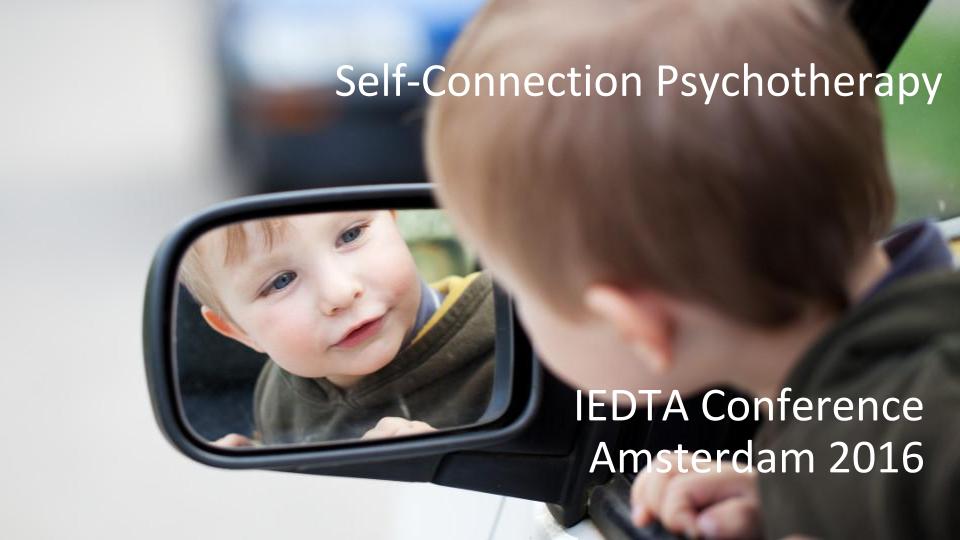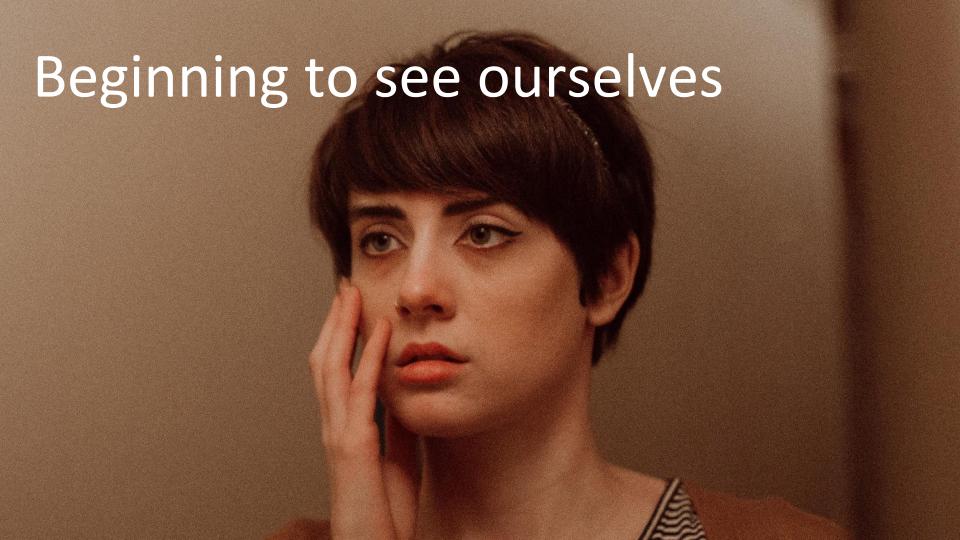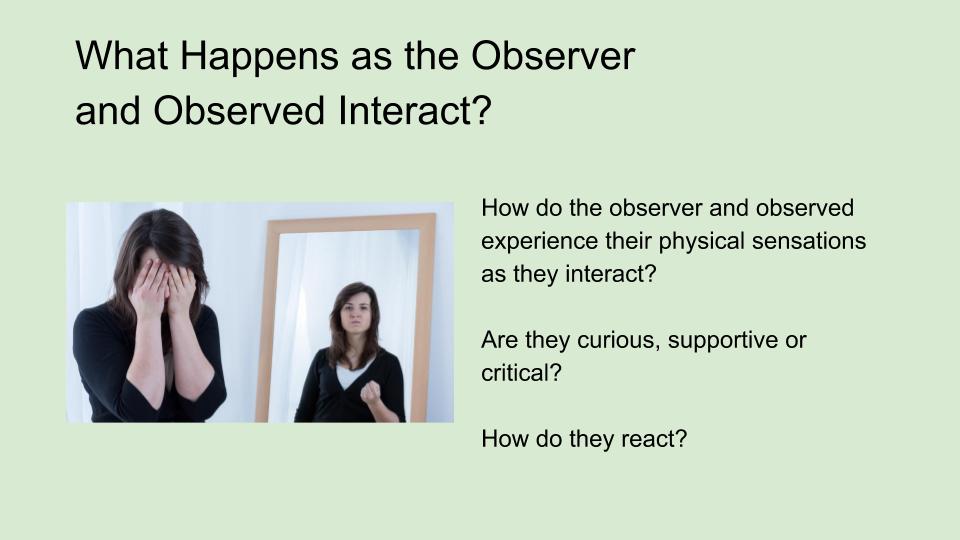
Part I
This post was created from notes and slides from a presentation about “Self-Connection Psychotherapy” at the 2016 IEDTA Conference.
During the past 40 years I’ve practiced psychotherapy and tried to develop ways of making it both briefer and more effective. Much of that time I focused on dynamic, empathic and sensory techniques.
I use video a great deal in my office. In the office the patient sits across from me. To the patient’s right there’s a large monitor that’s a split screen. Half of the screen shows the patient and half of it shows me. The images are large, magnified pictures of our faces on live feed from cameras that face each of us. To my right, there’s a similar screen that the patient can see. I spend a lot of time asking patients to pay attention to their facial expression.
One day when I was sitting in my office I happened to glance over at the image of me and was shocked. I looked very tired. I looked more “down” than the woman in the image below.

As I noticed how awful I looked I saw a smile come across my face. I felt much better and said to myself, “This is interesting. I wonder what’s going on.”
I realized that at the moment I’d felt compassion for myself, a smile had spread across my face. I thought, “I’ll look back at my face again later and see if this happens again.” I began to periodically take a peek over at my face. After a while, I could see that glancing over at my face and feeling tenderly about myself made me feel good, no matter how I looked.
Pretty reliably, glancing at my face made me feel better. This was a surprise because in the past when I looked at my face, I would find things to criticize, things I wanted to fix. Now, being concerned about how I looked was making me feel good. This was simply about me having concerned about me, and that made me feel good. Rather than focusing on what I wanted to fix, I was feeling compassion for myself. Things that had bothered me before or had been symptoms were disappearing. I was a happier guy.

Rather than having therapists solve their problems, people learn to connect with themselves in a way that causes many of their problems to disappear.
After about three months of this, patients began to say, “You know, you’ve changed,” and explained, “You seem more loving.” So my caring about myself came across as love for them. They felt loved and liked it. So I decided to see if I could help them develop this caring, loving feeling for themselves. I encouraged them to look at their image on the screen and watch for how they felt about themselves as well as examine any physical sensations they experienced.
Some people noticed a positive effect immediately. Others struggled. They had trouble looking at themselves.
Part II
Patients learned to make use of looking at their reflected image.
Here you see this picture of an infant holding its mother’s hand. See how the infant grasps the mother’s finger, and you see how gently the mother cradles the infant’s hand. The importance of this connection is obvious.
I began to realize that the tender sensation I experienced when I cared about myself (discussed in Part I of this series) was similar to the tender (chest swelling, moist eyed) sensations that arose in me as held my own infant.

Early sounds and images may be unclear to mother and child, but the bond between them is clear.
Bonding helps to create a safe environment. Bonding mothers feel wonderful caring for their infants. They do everything possible to see to the needs of their infants.

Bonding also promotes connection with others. In this slide, you see an older smiling baby and its mother looking at each other. Examine the expressions on their faces as they look at each other. They’re beginning to use all of their senses to build their connection. They use facial expressions, sounds, and smells. As they do so they also mirror each other’s expressions.

Bonding also helps children see themselves through loving eyes. Here, the child is bathed in the father’s loving gaze.
The goal of self-connection psychotherapy is seeing ourselves through OUR OWN LOVING EYES. That feeling of being SO LOVED by mothers and fathers, is something that people can actually give to themselves.

Bonding also promotes a connection with others. Here you see a child beginning to connect with others. You can see the joy on her face.
A smile can be very important. It invites connection. We’re drawn to it. We watch other’s faces, searching for smiles. A smile is welcoming.

How to begin to connect with ourselves… Here, you see a little boy looking at himself in the mirror. Children play with their image when they look at themselves in mirrors. They may touch and even kiss the mirror. Humans are one of the species of animals that can recognize themselves in mirrors.
This kind of connecting and caring appears to be related to bonding.

Part III
The self-connection process begins with people sitting in front of a live video image of themselves. They are encouraged to look at this magnified image and pay attention to their expression.
In this section:
- How do they describe the expression they see?
- What is their reaction to what they see?
Most people are woefully unaware of their facial expressions. They usually look at their faces to groom themselves, e.g., comb their hair, put on their makeup. They’re used to searching for expressions on the faces of others, but not searching their own face this way. They’re often surprised or troubled by what they see. If you take a minute to look into a mirror or to look at your face on a smartphone screen, you may get a sense of the expression on your face.
Think of yourself as an observer and think of the face on the screen, or in the mirror, as the part of you that’s being observed. What do you see on that face? Perhaps it’s sad like this young woman’s face. How does it make you feel to see the expression? Does it sadden you?
Next, put yourself in the shoes of the observed image. Explore the response of the observed part of yourself. How do you feel if your facial expression is saddening the observer?
The therapist’s job is to explore the interaction between the observing and the observed parts of you.

As the therapist explores the reactions of the “observer” and “observed,” there may be resistance by one or the other parts to looking at their reaction. At these times, the therapist asks if something is unsettling them or what they’re physically feeling. Whenever possible move toward the physical sensations that are being experienced.

The therapist asks, “What is the physical sensation like? Is the sensation something you feel in your face or somewhere else in your body?” Again ask the observing part to look at the eyes or mouth of the observed image. Then ask, “What happens when you look” Is the observing part curious about what it sees? Is it supportive? Is it critical?
When defenses begin to slow the therapeutic process frame them as valuable signals. These signals remind us to look for physical sensations. Intellectualization and avoidant defenses can be signalling us that something important is going on.

Sometimes, feelings can be overwhelming and when people are overwhelmed, they need help in dealing with their feeling.
People need to feel safe to explore things that scare them. When they’re overwhelmed, they may not be able to handle frightening sensations. It is the therapist’s job to find ways to help people manage frightening sensations so that they can make use of them. Perhaps feeling only a small bit of the sensation, rather than all of it, will make them feel safer. Will it be easier to explore a terrifying sensation someone else is struggling with rather than feeling the sensation themselves? The therapist might ask, “What would it be like to see someone else struggling with this sensation?”
Keep letting people know that each of their responses is useful. Everything they see– Every time they try to avoid something– Examining their responses can help them connect with themselves.

In summary, this is about teaching self-care. As we become more connected with ourselves, we care more for ourselves. We begin to explore our world and the people we meet with more enthusiasm, and if this happens, old symptoms, self-attacking behaviors melt away.
For more information about self-connection in psychotherapy,
subscribe or contact us.
